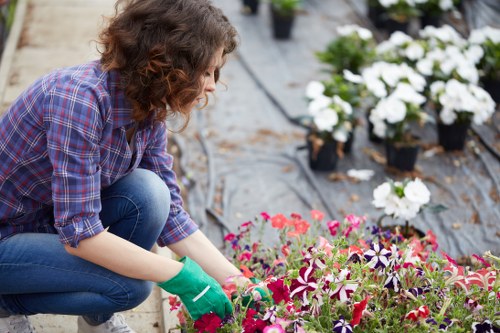Garden Fence Replacement in Jet Washing

Maintaining a beautiful and functional garden often involves ensuring that your fencing is in top condition. Over time, garden fences can suffer from wear and tear due to weather, pests, or general usage. Garden fence replacement is essential not only for aesthetic purposes but also for the security and integrity of your property.
One critical aspect of fence replacement is the preparation process, where jet washing plays a pivotal role. Jet washing, or power washing, effectively cleans the fence, removing dirt, mold, and old paint, which ensures that the new materials adhere properly and look pristine.
In this article, we will delve deep into the reasons for replacing your garden fence, the materials you can choose from, the integral role of jet washing in the replacement process, and maintenance tips to keep your new fence looking its best for years to come.
Why Replace Your Garden Fence?

There are several compelling reasons to consider replacing your garden fence. Understanding these can help you make an informed decision and ensure that your investment enhances the value and appearance of your property.
Enhancing Aesthetic Appeal
A worn-out or outdated fence can detract from the overall beauty of your garden. Replacing it allows you to choose a style and material that complements your landscape, adding to the curb appeal of your home.
Improving Security
Old fences may have gaps, rusted parts, or weak structures that compromise your garden's security. A new fence ensures that your property is well-protected against unwanted intrusions.
Increasing Property Value
Upgrading your fence can significantly boost the market value of your home. Potential buyers often look for well-maintained properties, and a new fence can be a major selling point.

Additionally, environmental factors such as extreme weather conditions can accelerate the deterioration of fence materials. Regular replacement ensures longevity and reduces the need for frequent repairs.
Eco-friendly fence options are also available, allowing homeowners to make sustainable choices that benefit both the environment and their communities.
Ultimately, replacing your garden fence is a proactive measure that contributes to the overall functionality and beauty of your outdoor space.
Choosing the Right Fence Material
[pimg]Selecting the appropriate material for your new fence is crucial. It affects not only the fence's appearance but also its durability, maintenance needs, and cost.
Wood Fences
Pros and Cons
Wood is a traditional and versatile fencing material. It offers a natural look that blends seamlessly with garden environments.
- Pros: Aesthetic appeal, customizable, renewable resource.
- Cons: Susceptible to rot, pests, and requires regular maintenance.
Vinyl Fencing
Benefits and Drawbacks
Vinyl fences are known for their low maintenance and longevity. They resist weathering, do not rot, and are easy to clean.
- Benefits: Durable, colorfast, and easy to install.
- Drawbacks: Limited color options, can be more expensive initially.
Metal Fences
Advantages and Disadvantages
Metal fences, including aluminum and wrought iron, offer strength and security. They are often chosen for their modern aesthetic and durability.
- Advantages: Long-lasting, requires minimal maintenance, enhances security.
- Disadvantages: Can be prone to rust (especially iron), higher cost.

Other materials like composite fences and bamboo are also gaining popularity due to their unique benefits and eco-friendly properties.
When selecting a material, consider factors such as climate, budget, desired look, and the level of maintenance you're willing to perform.
Consulting with a fencing professional can provide valuable insights tailored to your specific needs and preferences.
The Role of Jet Washing in Fence Replacement

Jet washing is an essential step in the fence replacement process. It ensures that the surface of the fence is clean, which is critical for both the removal of old materials and the preparation for new ones.
Cleaning and Preparing the Fence
Benefits of Jet Washing
Jet washing effectively removes dirt, debris, mold, and mildew, which can compromise the integrity and appearance of the fence.
- Eliminates contaminants that can cause decay.
- Prepares the surface for painting or staining.
- Ensures better adhesion of new materials.
Removing Old Paint or Finish
Enhancing Adhesion for New Treatments
Old paint and finishes can prevent new coatings from adhering properly. Jet washing strips away these layers, providing a fresh surface that enhances the longevity of new treatments.
- Prevents peeling and flaking of new paint.
- Ensures a smooth and even finish.
- Reduces the likelihood of future maintenance issues.

Moreover, jet washing can extend the life of metal and wooden fences by removing corrosive elements and preventing further deterioration.
Using jet washing as part of your fence replacement strategy not only improves the final appearance but also contributes to the structural integrity of the new fence.
It's important to use the correct pressure settings and techniques to avoid damaging the fence during the cleaning process.
Steps to Replace Your Garden Fence

Replacing a garden fence involves a series of steps that ensure the new installation is both functional and aesthetically pleasing. Here's a comprehensive guide to help you through the process.
Planning and Measurement
Accurate planning is the foundation of a successful fence replacement. Begin by measuring the area where the fence will be installed to determine the amount of material needed.
- Check local regulations and obtain necessary permits.
- Decide on the fence style and material.
- Mark the fence line to guide installation.
Demolition of the Old Fence
Before installing the new fence, remove the existing one carefully. This involves dismantling the panels or removing the entire structure if necessary.
- Use appropriate tools for demolition.
- Dispose of old materials responsibly.
- Inspect the fence line for any damage that needs repair.
Installing the New Fence
Jet Washing Techniques
Once the old fence is removed and the area is clean, prepare for the installation of the new fence. Jet washing can be used to clean the fence posts and ensure they are free from any residual debris.
- Set the correct pressure to avoid damaging posts.
- Allow the fence posts to dry completely before installation.
- Apply protective coatings if necessary.

Following preparation, begin installing the new fence according to the manufacturer's instructions. Ensure that the posts are firmly anchored and the panels are securely attached.
Take your time to align the fence properly, maintaining consistency in height and spacing for a professional finish.
Once installed, perform a thorough inspection to ensure that the fence is sturdy and meets your expectations.
Maintenance Tips for Your New Fence

Proper maintenance extends the life of your new fence and keeps it looking its best. Regular upkeep prevents minor issues from becoming significant problems.
Regular Cleaning
Keep your fence clean by removing dirt, debris, and any biological growth such as mold or mildew. Jet washing can be part of your regular cleaning routine to maintain its appearance.
Protective Coatings
Applying protective coatings like paint or sealant adds a layer of defense against environmental factors. It helps preserve the material and enhances its durability.
- Reapply coatings as recommended by the manufacturer.
- Choose eco-friendly and long-lasting products.
- Ensure proper ventilation when applying coatings.
Inspection and Repairs
Regularly inspect your fence for any signs of damage or wear. Promptly address issues such as loose boards, rust spots, or leaning sections to prevent further deterioration.
- Replace damaged panels immediately.
- Tighten any loose fittings or fasteners.
- Treat and protect against pests and rot.

By adhering to these maintenance tips, you ensure that your garden fence remains a valuable and attractive part of your outdoor space for many years.
Consistent upkeep not only preserves the visual appeal but also enhances the functionality and security your fence provides.
Investing time and effort into maintenance saves costs in the long run by avoiding extensive repairs or premature replacement.
Conclusion
Replacing your garden fence is a significant project that can greatly enhance the beauty, security, and value of your property. By carefully selecting the right materials, utilizing effective jet washing techniques during the replacement process, and maintaining your new fence properly, you can ensure a lasting and rewarding investment.
Don't wait until minor issues become major problems. Contact us today to schedule your garden fence replacement and experience the difference a professional touch can make.
Book your service now and take the first step towards a stunning and secure garden.